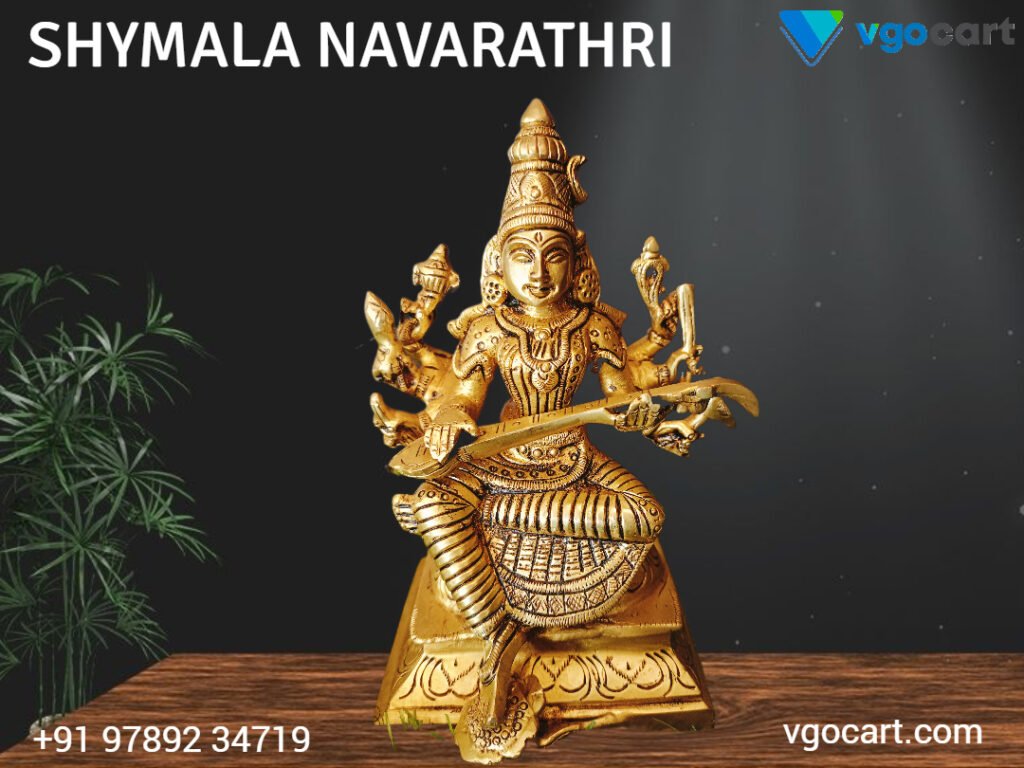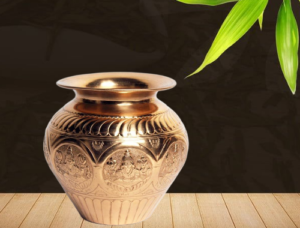Blog
Shyamala Navaratri 2024 – Goddess of 64 Arts, Great Benefits Rajamathangi
SHYAMALA NAVRATRI – Rajamathangi
NAVRATRI:
The nine divine nights of Navratri is the most popularly celebrated festival of Hinduism dedicated to the goddess Durga(Shakthi). Goddess Parvati is decorated and celebrated in 9 different forms on each day of Navratri representing the celebration of feminine power. In general, Navratri is of 4 types celebrated at each period of the year in which some are left unknown and people are not aware of it. The Navratri celebrated during the time of Diwali is the well-known form and the rest is known only to the devotees of Maa Parvati Devi (Shri vidya ubasagargal)
Navratri is celebrated to honor the divine goddesses at a certain interval of time in which 4 seasons of Navratri are celebrated in a year. It is followed as per Tamil month such as,
- During Puratasi month – Saradha Navratri (September- October)
- During Aadi month – Ashada Navratri (July- August)
- During Thai month- Shyamala Navratri (January – February)
- During panguni month- Vasantha/ Chaitra Navratri (March – April)
WHAT IS SHYAMALA NAVRATRI?
Similar to other Navratri, this Shyamala Navratri is also the divine nine nights to honor and celebrate the female shakti in different forms in which here Goddess Shyamala or Matangi is represented. As it is not that much popular like others it is silently followed by shakthi ubasaragal in a very humble and simple manner.
This form of Shyamala Navratri is celebrated during the Tamil month on (Jan-Feb) Thai which starts after Amavasya day and continues for 9 days from pradhamai to navami. This Shyamala Navrathri includes Vasantha panjami( day 5) as it is good for vidyarambham (studies), Radha Sabthami (day 7), and Beshmashtami (day 8) which are considered as special days.
WHO IS SHYAMALA DEVI – Rajamathangi
Shyamala Devi or Goddess Shyamalai is also known as Devi Matangi, Raja Matangi, Sri Raja Shyamala, Maha Mandhirini. She is the 9th among 10 Dasa Mahavidya, the 10 tantric divine forms of mother goddesses. Shyamala Devi is believed to have originated from the sugarcane bow (karumbu vill) of goddess Sri Lalitha Tripura Sundari. She is also known as Mantrika and Raja Paripalani of Lalitha.
Shyamala Devi is the 9th Vaaghdevi and being the Vedha matha she is represented as Adhi Devatas. Matangi is the Mahamandhiri and adviser of Sri Lalitha Parameshwari and also the prime manthiri who carried the royal emblem with her and known by the name Muthreshwari.
FEATURES OF SHYAMALA DEVI:
Shyamala Devi or Goddess Matangi is said to have the dark emerald green texture with 8 hands holding weapons like noose, sword, goad, club, a floral garland of white lotus and kadamba flowers(hence called as KadambaVanaVasini), 2 parrots, playing a rudy stoned veena, conch-shell earrings along with a crescent moon decorating her crown seated on a royal throne.
In which each represents a unique meaning;
- Green color- knowledge
- Veena – music
- Parrot – speech
- Floral bow- Art and success
- Paasaam- Attractiveness
- Ankusham- Control
- Sugarcane- worldly desires
WHY DO WE PRAY AND CELEBRATE SHYAMALA NAVRATRI?
This Shyamala Navratri is celebrated mainly for the girl children in a very simple way unless and unlike the other Navratri days which is decorated with golu format. Goddess Shyamala Devi is the 9th Vaaghdevi and hence provides us the blessings of Vaag Balitham and Ashtama siddhi to create an auspicious life to everyone praying to her on this Shyamala Navratri.
Praying goddess Shyamala during this Shyamala Navratri will enhance our abilities and talents of arts, speech, knowledge, studies, etc. Shyamala Devi is the embodiment or deity or essence of thoughts and so-called as (Akarshana Shakthi) Jnana shakti of Tripura Sundari. Thus by worshipping Goddess Shyamala in this period of Shyamala Navratri will bestow as with all the desires of life we pray for.
PROCEDURES TO CELEBRATE SHYAMALA NAVRATRI:
Celebrating Shyamala Navratri takes only simple steps and procedures that every common person can follow to get the blessing of Goddess Shyamala Devi. Wake up early in the morning, refresh yourself as a divine person and prepare for pooja arrangements.
- Make your pooja room clean, neat, and tidy in every way possible.
- Adorn your home with flowers, mango leaves(Thoranam) rangoli, and other simple and elegant decorations.
- Clean a wooden board, cover it with Red or green colored cloth, and place the image or idol of Shyamala Devi of Goddess Meenakshi to honor them with a pooja.
- Lit lamp along naivedyams and dooba-aradhanas.
- Offer well-flavored flowers like jasmine, jathi malli flower garlands, and any kind of sweets which is possible to make.
- Arrange a poorna kumbam or poorna kalasam and place it for pooja.
- Chant the following mantras, slogans, Bajans, devotional songs, and parayanams for prayer during all the 9 days of Shyamala Navratri.
BENEFITS OF SHYAMALA NAVARATRI (RajaMatangi):
In Shyamala Navratri goddess Shyamala is the embodiment of knowledge, talent, and expertise as she is the combination of Trishakti. Hence praying goddess Raja Matangi in this Shyamala Navratri will provide us with the following benefits.
- She provides the blessings of Jnana(Knowledge) and fulfillment of all our wishes and desires
- Children or students may get benefited by becoming well versed in studies and all other undertakings of life.
- Enhance the couple relationship between the husband and wife
- As she is the goddess of beauty, she provides us with the blessings of marriage, happy life, material gain, and happy life.
- Cures long-term disease and blesses with long life and progeny.
- She is the representation of 64 arts (Aaya kalaigal arupathu naangu)and bestows her grace on making a person attain proficiency in poetry, music, dance, all fine arts, and respective chosen field on an individual.
- Helps to remove our old karmic sins, mistakes, errors, and bondage of past life
- Provides child boon for childless couples, the job for jobless people, marriage offer for unmarried persons and giving the overall joy and prosperity as a whole.
Are Goddess Rajamatangi and Shyamala Devi the Same?
CHANTS FOR SHYAMALA NAVRATRI:
Sri Matangi Gayathri Mantra:
Om Matangyai Cha vidhmahe Uchhista Chandaalyai Cha Dheemahi,
Tanno Devi Prachodayat
Sri Shyamala Devi Gayathri Mantra:
Om Shyamalayai cha vidhmahe, Matang Jayai Dheemahi,
Tanno Devi Prachodayat
Shyamala Dhandakam- By Kalidas
Manikhya veenaam upalalayanthim,
Madalasam manjula vaag vilasam,
Mahendra Neela dhyuthi komalangim,
Mathanga kanyam manasa smarami…
…Sarva Theerthamike,
Sarva mantrathmike,
Srava yantrathmike,
Sarva shakthyathmike,
Sarva peedathmike,
Sarva thathwathmike,
Sarva vidhyathmike,
Sarva yogathmike,
Sarva nadathmike,
Sarva shabdathmike,
Sarva viswathmike,
Sarva vargathmike,
Sarva sarvathmike,
Sarvage, Sarva roope, Jagan mathruke,
Pahi maam, Pahi Maam, Pahi maam,
Devi thubhyam namah, Devi Thubhyam namah. Devi thubhyam namah.
Lalitha Sahasranamam- By divine 8 vaag devis
Asyashrilalita sahasranama stotras mahamantrasya,
vashinyadi vagdevata Rushayah anushtup
chandaha shree lalita parameshari devata
shrimadvagbhava Kutetibijam madhyakuteti shaktih
shaktinyasam karanyasancha kuryat mama
Shree lalita parameshari prasada sidhyardhe jape viniyogah…
To know more about Lalitha Sahasranamam:
Abirami Andhadhi- By Abhirami bhattar
Noorpayan;
Aaththaalai, engal abiraama valliyai, andam ellaam
pooththaalai, maadhulam poo niraththaalai, puvi adangak
kaaththaalai, amgaiyil paasangusamum karuppuvillum
serththaalai, mukkanniyaith, thozhuvaarkku oru theengu illaiye.
Rajamathangi mantra:
Om Hrim Aim Shrim Namo Bhagvati Ucchishtachandali
Shri Matangeswari Sarvajanavasankari Swaha
Meenakshi pancharathnam – By Adhi Shankarar
Udyad bhanu sahasra-koti sadrsham keyura haarojwalam
Bimboshteem smitha danta pankthi ruchiram peetambara-alamkrutam
Vishnu brahma surendra sevita padaam tatvaswa rupam sivaam
Meenakshim pranathosmi santata maham karunya vaaraam nidhim
Mukthahaara lasat kireeta ruchiram poornendu vakthra prabham
Shinjannupura kimkini mani dharam padma-prabha bhaasuram
Sarvabheetha phalapradam girisutam vaani rama saevitam
Meenakshim pranathosmi santata maham karunya vaaraam nidhim
Shree-vidyaam shiva vamabhagha nilayam hreemkaara mantrojwalam
Srichakrankitha bindhu madhya vasathim srimath sabhaa nayekaam
Srimath Shamukha vignaraja jananeem Srimajjagan mohineem
Meenakshim pranathosmi santata maham karunya vaaraam nidhim
Srimat sundara nayakeem bhayaharaam gnaana pradam Nirmalaam
Shyamabhaam kamalasanaarchitha-padam narayanasyaanujam
Veena veenu mrudanga vaadya rasikaam nanavidhaam ambhikam
Meenakshim pranathosmi santata maham karunya vaaraam nidhim
Nanaayogi muneendra hruthya vasathim nanaardha siddi pradam
Nanaa pushpa virajithanghri yughalam narayanae-narchitham
Naada brahma mayeem paraath parataram nanardha tatvatmikaam
Meenakshim pranathosmi santata maham karunya vaaraam nidhim
Iti srimatparamahamsa parivrajakaacharyasya
Srigovinda bhagavatpujya padashishyasya
Srimacchankara bhagavatah krutau
Meenakshi pancharatnam sampoornam.
Other chants or mantras include:
- Sri Shyamala Sahasranamam
- Sri Matangi Stotram
- Sakala kala valli malai
By chanting these divine mantras wholeheartedly during this Shyamala Navratri will bestow us with everything joy and prosperity we need in this worldly life.
POOJA FROM DAY 1 TO DAY 9
- Day 1 – Laghu Shyamala
Tithi- Magha sukla pratipada
- Day 2 – Vagvadini Shyamala
Tithi- Magha sukla Dwitiya
- Day 3 – Nakuli Shyamala
Tithi- Magha sukla Tritiya
- Day 4 – Hasanti Shyamala
Tithi- Magha sukla Chavithi
- Day 5 – Sarvasiddhi Matangi
Tithi- Magha Sukla Panchami
- Day 6 – Vasya Matangi
Tithi- Magha Sukla Shashti
- Day 7 – Sarika Shyamala
Tithi- Magha Sukla Sapthami
- Day 8 – Suka Shyamala
Tithi- Magha sukla Ashtami
- Day 9 – Raja Matangi
Tithi- Magha Sukla Navami
Benefits of Rajamathangi Homam and Yagam
OTHER NAMES OF SHYAMALA DEVI:
Goddess Shyamala Devi is also represented in varion names such as
- Geya Chakra Vaashini
- Laghu Shyamala
- Vaghvadhini Shyamala
- Nakhula Shyamala
- Hasanthi Shyamala
- Sarvasiddhi Matangi
- Vasya Maatangi
- Sarika Shyamala
- Suka Shyamala
- Rajamatangi 2024
- Shyamala Images Wallpaper
One thought on “Shyamala Navaratri 2024 – Goddess of 64 Arts, Great Benefits Rajamathangi”
Leave a Reply
You must be logged in to post a comment.




Excelldng reading this . I need more info